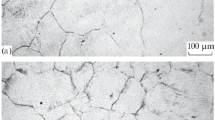Conclusions
-
1.
High-temperature vacuum carburizing provides higher strength of the core of machine parts made of alloy steels as compared with standard carburizing.
The variation of the ductile characteristics is more complex: The reduction in cross-sectional area remains unchanged for steel 19KhGN but increases for steels 20KhGN and 16KhG, while the relative elongation decreases ∼20%.
-
2.
The fracture toughness of the core of parts is 20\2-100% higher after vacuum carburizing than after standard carburizing.
-
3.
Repeated quenching of carburized parts with intermediate cooling to a temperature below eutectoid temperature leads to substantial austenite grain refining.
The austenite grain size of steels 16KhG and 19KhGN (0.037% A1) is no higher than the original after vacuum carburizing, but one to two grades larger than the original grain size of steels 20KhGNM and 19KhGN (0.02% A1).
-
4.
The effect of repeated quenching on grain refining after high-temperature carburizing depends on the temperature threshold of coalescence and solution of particles of second phase that prevent austenite grain growth.
Repeated quenching is expedient even after standard carburizing of steels deoxidized with aluminum.
Similar content being viewed by others
Literature Cited
A. D. Assonov, Technology of Heat Treating Machine Parts [in Russian], Mashinostroenie, Moscow (1969).
V. A. Borodulya, G. G. Tyukhai, and V. A. Nemkovich, "High-temperature carburizing of steel in furnaces with an electrothermal fluidized bed", in: Heat and Mass Exchange in Biphase Systems and Chemical Conversions [in Russian], Minsk (1977).
V. I. Murav'ev, "Carburizing in a pseudofluidized bed of carbon-graphite materials," Metalloved. Term. Obrab. Met. No. 11, 70 (1977).
V. G. Podoinitsyn, "Gas flame carburizing of steel 20," Metalloved. Term. Obrab. Met., No. 7 (1974).
V. G. Podoinitsyn, "Some characteristics of high-temperature carburizing of steel," in: Technology and Organization of Production [in Russian], No. 3, 44 (1973).
H. Western, Met. Progr., No. 4 (1972).
Industrial Heating, No. 9, 1650 (1972).
H. Terauchi, "Vacuum carburizing," Kindzoku Dzaire,14, No. 8, 45 (1974).
M. Sugiyama and H. Iwata, "Carburizing in vacuum," Kindzoku Dzaire,17, No. 5, 25 (1977).
Yu. P. Usatyi et al., Vacuum Carburizing [in Russian], Electrothermy Series, No. 8 (1977).
V. D. Kal'ner et al., "New methods of chemicothermal treatment of structural steels in automobile construction," Metalloved. Term. Obrab. Met., No. 7, 67 (1978).
S. Terauchi, H. Terauchi, and K. Kamei, Heat Treatment, No. 5 (1976).
V. D. Sadovskii et al., "Lithoidal fracture in alloy structural steels", Stal', No. 6, 545 (1955).
Ya. E. Gol'dshtein and T. P. Mushtakova, "Lithoidal fracture of steel," Metalloved. Term. Obrab. Met., No. 5, 70 (1978).
Additional information
Tol'yatti Polytechnic Institute.Volga Automobile Factory. Translated from Metallovedenie i Termicheskaya Obrabotka Metallov, No. 6, pp.2–7, June, 1980.
Rights and permissions
About this article
Cite this article
Krishtal, M.A., Tsepov, S.N. Properties of steels after high-temperature vacuum carburizing. Met Sci Heat Treat 22, 379–385 (1980). https://doi.org/10.1007/BF00693636
Issue Date:
DOI: https://doi.org/10.1007/BF00693636




